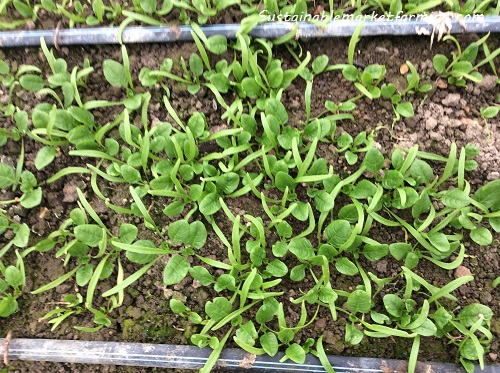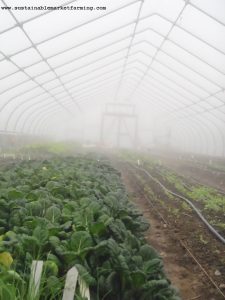
Photo Pam Dawling
Success with Spinach for Fall, Winter and Spring
Spinach is a much-loved crop for us. We sow outdoors and in the hoophouse in early September for harvesting from fall through to spring (April). We sow outdoors in late September for a crop to overwinter as small plants and be harvested in the spring. We also sow in our coldframes in mid-September. These are more sheltered than the beds outdoors, and the spinach makes faster growth. We sow more spinach in the hoophouse in October and November. We sow in the hoophouse in January to transplant outdoors and in the hoophouse in February for spring harvests. We are able to keep harvesting spinach (leaves, not whole plants) from October 15 to May 25, all the way through the winter. Central Virginia is too hot to have spinach during the summer (we switch to chard).

Photo wren Vile
Unsurprisingly, I have written about spinach several times.
Spinach Variety Trials Conclusion in May 2019. Our top general favorite is Acadia, although Reflect does better outdoors overwinter. This post includes links to earlier posts about spinach varieties, including Spinach Trials Update, April 2018.
What causes spinach leaves to turn yellow, in May 2019

Photo Pam Dawling

Photo Pam Dawling
What makes vegetable crops bolt and how can I stop it? March 2021
Spinach Varieties
Choose varieties that do well in climates similar to yours, in the conditions you have when you plant and harvest. We used to grow Tyee for all plantings, and were very happy with it. But it has been pulled from the market because it had disease problems in the Pacific North West, where spinach seed is grown. We have tried and not continued Chevelle, Corvair, Renegade (grows fast, but has thin leaves and bolts early in spring), Avon (Downy Mildew in winter).
Also see the 2015 Greenbank Farm Spinach Variety Trial. The farm is in Washington State. They evaluated 10 varieties of savoyed and semi-‐savoyed spinach with two side-‐by-‐side replication in spring. Abundant Bloomsdale, Bloomsdale Long Standing, Butterflay, Giant Winter, Dolce Vita, Longstanding Bloomsdale, Lyra, Solstizio, Tyee, Winter Bloomsdale. The overall star of their trial was Solstizio from Nash’s Organic Produce.

Photo Pam Dawling
Paul and Sandy Arnold in Argyle, New York, made a great slide show reviewing Spinach Varieties in High Tunnels. I think it’s no longer available online, but I did learn that in 2019, their top Winter Spinach Varieties were Escalade, Carmel, Whale, Space, Reflect; top Summer Spinach Varieties: Banjo, Seaside, Woodpecker.
In 2011-2012, High Mowing Seeds in northern Vermont did a spinach variety trial with 24 varieties. Three farmers in Iowa conducted a 2021 trial of spinach varieties and seedling methods. They compared yield, bolting and yellowing among three spinach seeding methods: seeder (1x rate), seeder (2x rate), hand-seed (2x rate); and between two varieties (Kolibri, Kookaburra). Two of them found no statistically significant difference of seeding method on yield; one found no difference in yields between the two varieties, but using a seeder at a double rate produced significantly higher yields than the other two methods.
When to sow fall spinach
Spinach does not germinate in hot soil! Use a soil thermometer and wait for the soil to cool to 68F (20C), or see the next section about sprouting spinach seed in a cold place. If you have no soil thermometer, see my post chickweed, hen-bit and dead-nettle, and use the info that was originally written with lettuce in mind, for spinach! There are photos there of these three plants at seedling stage. These are winter annual weeds here, that don’t grow in summer. Once we see their seedlings emerging in late August (a cool summer year like 2023) or September (most years) we know the soil has cooled enough to sow lettuce and spinach directly in the ground.
A trick for getting good timely germination of spinach seed is to put it (in sturdy resealable plastic bags or jars) in the freezer for about two weeks. Take the seeds out of the freezer the day before you want to sow (or start sprouting them), but – important – do not open the bag or jar. Leave it to warm to ambient temperature before opening. Otherwise the warm humid air will rush in and coat the cold seeds with condensation, reducing the shelf life of whatever seed you have left over for another time.
See our Spinach Variety Trials and Planting Plan, in February 2018:
- September 6 is our first sowing (sprouted seeds) in the hoophouse for winter harvest 10/30-2/15, or later if it doesn’t bolt.
- We sow outdoors on September 7 (sprouted seeds) for growing under rowcover and harvesting in fall and winter.
- September 18-20 we sow in our coldframes and outdoors for harvest in early spring, until late May.
- October 24 we make our second hoophouse sowing, to feed us November 25 to May 7.
- On November 9,we make a third hoophouse sowing, intending to use these plants to fill gaps in our hoophouse as other winter crops come to an end.
- January 16 we make more sowings in the hoophouse, some to continue to fill gaps there along the edges of the beds where they won’t fight with the tomatoes and so on, which we transplant starting March 15. Most of the spinach sown on this date is for transplanting outdoors on February 21.
- January 29 we sow in flats in the greenhouse if we see we haven’t got enough bare-root transplants in the hoophouse.
- February 10 If we don’t have enough transplants, then on this date we sow outdoors with rowcover, for spring harvests until May 25 if we’re lucky. We have backup plans on backup plans for this!
- In the hoophouse we continue transplanting spinach to fill gaps until March 31.

Photo Pam Dawling
Sprouting Spinach Seed
This very easy work-around involves soaking the spinach seed in water overnight, draining it, and putting the jar on its side in the fridge for a week. If you remember, give the jar a quarter-turn each day to even out the moisture. You are not growing bean sprouts! A little neglect will not cause harm. The ideal is to have short sprouts, not long ones, as those break off more easily. Sow the seed in the furrows gently, by hand. If the sprouts have got tangled, add some water to float them apart, drain them, spread them on a tray, or a layer of rowcover, to dry a bit, then mix with some inert dry soil-friendly material like uncooked corn grits or bran, which will help them not stick together.
Sowing Spinach in Speedling Flats and Floating them in Water
Another option is to start the spinach in flats and transplant it all. That’s a lot of work, but we found we could save on the daily attention time and the transplant time by using 120-cell Styrofoam Speedling flats. Sow one or two seeds per cell, then float the flats all day in water. Depending on your scale, this could be a baby bath or a stock tank. Remove the flats each evening and let them drain all night (while it is hopefully cooler). With just twice a day visits and no hand-watering, this is a big time saver, and we have got good germination rates.

Photo Denny Ray McElya
When it comes time to transplant, the tool of choice is a butter knife. Use the knife to wiggle a wedge-shaped hole in the bed. Slide the knife down the sloping side of the cell, and, holding the base of the plant with one hand, use the knife hand to lift and flick the plug out. If all goes well, the plug will be then be resting on the now-horizontal knife, and you can slide it into the pre-made hole and firm it in.
Growing Spinach
Spinach makes growth whenever the air temperature is 40F (4.4C) or more. So any winter protection you can provide, in the way of cozy microclimates, rowcover, coldframes, or a hoophouse, will increase your yield. Spinach is more cold-hardy than many people realize. It dies at 0°F (-18°C) unprotected outdoors. Savoyed varieties tend to be a little hardier than smooth-leaved types. Large-leaved savoyed spinach outdoors with no protection can get seriously damaged at 10F (-12C). Small-leaved plants are OK down to 5F (-15C).

Photo Wren Vile
Our outdoor spinach gets hoops and thick rowcover (Typar, 1.25 oz/sq yd spunbonded polypropylene, with 75% light transmission, and about 6 F (3.3 C) degrees of frost protection). It can last for 6 years or more. When we got 0F (-18C) the spinach leaves that touched the rowcover got big patches of beige/tan dead cells, but the plants recovered to produce more leaves.
Ben Hartman (author of The Lean Farm) wrote Testing the Limits of Cold Tolerance in Growing for Market magazine in February 2014. He reported that his young hoophouse spinach in Goshen, Indiana, with mid-weight rowcover survived -16F (XXX). Ben points out that spinach less than 1″ (2.5 cm) tall is very cold-tolerant. Bigger plants need more protection if it’s going to get that cold.
You can read more about growing spinach in my Cooking Greens monthly series.
Growing bare root spinach transplants

We grow our spring spinach transplants (as well as kale and collards) in the soil in our hoophouse, sowing them in late January. See bare root transplants . You can find more links and info in that post. Growing bare root transplants saves a lot of work and a lot of greenhouse space.
Harvesting Spinach
Our goal is sustainable long-season harvesting. This is important for winter crops, as making a new sowing during cold dark days will not produce much food until spring comes around. It’s like the goose that lays the golden eggs – keep the leafy “golden eggs” coming
We harvest spinach by cutting individual leaves and leaving the plant to continue to produce more.
Our rule is “Leave 8 for later” – cut off large outer leaves close to the base of the plant, being sure to keep at least 8 of the inner leaves growing on each plant. Over-harvesting leads to decline.
When we finally pull up the bolting plants in spring, I’m always amazed to see how many leaf-scars there are on each plant, showing just how much we’ve harvested.

Photo Pam Dawling
For those relatively new to this blog but living in a similar climate zone, I want to point you to The Complete Twin Oaks Garden Task List Month-by-Month. It includes a link for each month’s task list. I notice from the site stats that some of you are finding your way there, but now there are so many years’ worth of posts it’s perhaps harder to find. Happy browsing!


